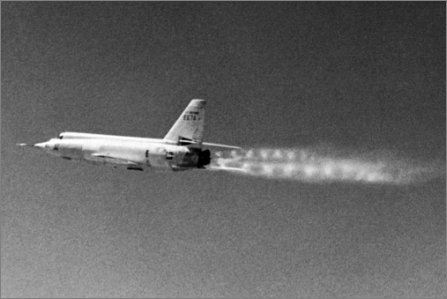While DARPA’s oblique flying wing has the hallmarks of an X-plane, the programme has several hurdles to overcome before it can follow in the illustrious footsteps of experimental aircraft such as the swept-wing Bell X-2 and forward-swept wing Grumman X-29.
Experimental aircraft programmes have notoriously high mortality rates, which have increased in recent years as financial pressures and operational priorities have made the move from laboratory exploration to flight demonstration even more challenging. DARPA has seen several promising programmes fall after failing to win the backing of their intended customers.
|
| Grumman's X-29 proved forward sweep to be manoeuvrable and controllable |
In their heyday, X-planes were the stuff of legends. Although not the first to travel faster than the speed of sound, or the first to reach Mach 2, the rocket-propelled X-2 secured its place in history by becoming the first aircraft to exceed M3. Such was the pace of progress back then that less than nine years elapsed between the Bell X-1 breaking the sound barrier in 1947 and the X-2 reaching three times the speed of sound.
The X-2’s classic swept-wing planform dominated high-speed aircraft design for decades to come, and it was not until 1984 that a truly different shape took to the air. The X-29 was designed to test a forward-swept wing and close-coupled canard, which together promised higher manoeuvrability, lower supersonic drag and reduced weight. The X-29 may not have had the visible influence on aircraft design that the X-2 did, but its technologies for aeroelastically tailoring a thin supercritical wing and digitally controlling a highly unstable configuration are now part of every high-speed aircraft.
Like the swept wing and forward-swept wing, the oblique flying wing is a concept that has to be flown to be believed, and X-planes still have a pivotal role to play in proving the feasibility of new technologies and configurations. After a flurry of X-programme launches in the 1990s, however, relatively few are still active, and one of DARPA’s broader goals to reduce the cost and time required to design and test an X-plane. One consequence is that most recent X-planes are unmanned.
X-plane programmes that are still active include the X-37 reusable spaceplane technology demonstrator, X-48 blended wing-body testbed, X-50 high-speed rotorcraft and X-51 scramjet flight demonstration. The X-45 and X-47 unmanned combat air vehicle demonstrators have been cancelled, meanwhile, but could still be resurrected. Programmes vying for X-plane status include the OFW and DARPA’s Heliplane high-speed gyrodyne (Flight International, 21-27 February).
After a tortuous history that saw Boeing’s X-37 transferred from NASA to DARPA and reduced to an atmospheric drop-test programme only, the spaceplane demonstrator achieved a milestone on 7 April, albeit with mixed success. Carried aloft by Scaled Composites’ White Knight, the unmanned vehicle was dropped from 37,000ft (11,300m) and landed autonomously on the runway at Edwards AFB, California. Although the touchdown was “flawless”, according to DARPA, the vehicle did not stop as planned and rolled off the runway, damaging the nosegear.
The future of the Boeing’s X-45 and Northrop X-47 UCAVs are uncertain following cancellation of the Joint Unmanned Combat Air Systems (J-UCAS) programme, which involved DARPA, the US Air Force and US Navy. DARPA successfully completed its UCAV technology demonstration with the original X-45A in 2004, and the first of the larger X-45C and X-47B vehicles were at or near completion when J-UCAS was terminated this year.
The US Navy now plans to demonstrate a carrier-suitable, low-observable vehicle in 2011 as a step towards fielding a carrier-based UCAV for persistent surveillance and strike. This is expected to be something like the X-47B. At the same time, the US Air Force is expected to look at even larger UCAVs for its long-range strike requirement.
The dream of building an aerodynamically and structurally efficient blended wing-body transport is being kept alive, albeit barely, by the X-48 programme. A 10.7m-span low-speed test vehicle, the X-48A, never flew, but Boeing and NASA plan to fly a 6.4m-span, 8.5%-scale X-48B model this year. NASA conducted tethered free-flight, remote-control tests of a smaller, 5%-scale model in the windtunnel late last year (Flight International, 22-28 November 2005).
|
| Bell's X-2 pushed the swept wing concept beyond Mach 3 as early as 1956 |
Boeing’s X-50A Dragonfly, another DARPA programme, nearly came to an untimely end when the unmanned canard rotor/wing (CRW) demonstrator crashed in March 2004 on only its third hover flight. Cross-coupling of the rotor controls was found to be the cause of crash and the second demonstrator was modified and extensively tested on the ground before making its first flight in December last year. The stopped-rotor CRW is designed to combine the speed and range of an aeroplane with the flexibility of a helicopter, and first ever conversion from rotary-wing to fixed-wing flight and back again is planned for this year.
The latest programme to get an X-plane designation is the X-51A, an air-launched missile powered by a hydrogen-fuelled scramjet. Planned for launch from NASA’s B-52 in 2008, and accelerated to M4.5 by a solid rocket booster, the X-51A will test Pratt & Whitney’s HyTech scramjet at up to M7.
Later, DARPA plans to combine the HyTech scramjet with an M4 expendable turbine engine to demonstrate a turbine-based combined cycle engine able to accelerate a hypersonic cruise vehicle to speeds exceeding M7. Technology for a rapid-response, global-range strike vehicle is being developed by Lockheed Martin under DARPA’s Falcon programme. The goal is to bring these efforts together in a large-scale hypersonic-cruise X-plane – one of the most ambitious X-plane programmes of recent decades.
Source: Flight International


















